Uncovering the mysteries of soil


CHERISHing our coastline
Imagining climate futures
127 Spring 2023 £2.50
No
Discovering the wildlife of CAT
Your support gives people across the UK and beyond the knowledge and skills to build a better world.
It’s a gift for everyone who will benefit from a safe, healthy and fair future in which nature thrives –including our children and future generations.
And by giving membership to your friends, family members and colleagues, they will enjoy:
• becoming part of a growing and thriving community of changemakers
• knowing that their membership supports urgent solutions to the climate and biodiversity crisis
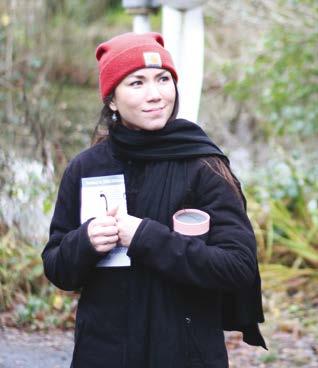
• reading Clean Slate magazine, delivered to their door four times a year
• coming to our award-winning visitor centre for free
• unwrapping a special membership pack with an exciting extra gift on the day.

BUY SOMEONE THE GIFT OF SUSTAINABILITY
CAT membership is a gift for everyone, everywhere.
CAT members everywhere are putting urgent solutions into action.
Buy someone the gift of membership today by calling 01654 705988 or visiting cat.org.uk/giftmembership
For more information please contact us at members@cat.org.uk
In this issue
10. Food, nature and wellbeing

Chris Higgins talks about the Tyfu Dyfi project bringing together a local community around growing and sourcing food in harmony with nature.
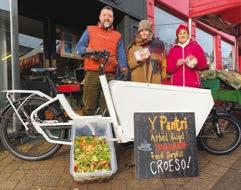
12. Worming through the soil
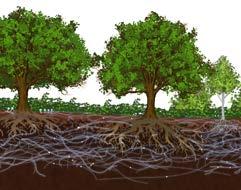
Richard Hartnup explores the wonder and complexity of the ground beneath our feet.
14. Wild CAT
Meet some of the species that have found a home at CAT, and learn about how we manage the site to create a haven for wildlife on what was once bare slate.
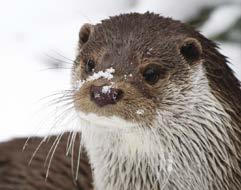
17. Join our Bioblitz
Help study the abundance of nature across the CAT site, or get involved with your very own backyard nature survey.
18. Making space for nature
A quick guide to helping wildlife where you are.
20. The crisis on our coastline
Hannah Genders Boyd introduces the CHERISH project raising awareness and understanding of the impacts of climate change on our coastal heritage.
24. Monitoring your heat pump’s performance
Joel Rawson looks at the importance of monitoring in keeping this technology delivering its best.
36. Keeping CAT’s pioneering spirit alive
Freya Randall shares the story of Elizabeth, a supporter leaving a gift to CAT in her will and encouraging others to consider giving in this way.
Regulars
3. Editorial
With CAT Interim co-Chief Executive Officer, Eileen Kinsman.
4. CAT news
All the latest news from the Centre.
27. Short course spotlight – Renewables for Households: Heat Pumps

Explore the science, weigh up the costs and benefits, and calculate the emissions reductions of heat pumps, to decide if this technology is right for you.
28. Why do we teach… futures literacy for sustainability transformation?
The latest in our new series looking at themes and topics explored by students on CAT Masters degrees – with Dr Ruth Stevenson
31. Meet CAT’s… Graphic Designer
John Urry talks about bringing CAT’s communications to life with his creative design skills.
33. CAT stories
Meet some recent CAT graduates who are putting learning into practice.
35. Cryptic crossword
Stretch your brain with Brominicks.
Cover image: Pine marten at dusk in woodlands near CAT – Jason Hornblow, jchphoto.co.uk
Editor: Catriona Toms.
Design: Graham Preston (grahamjpreston@hotmail.com).
The opinions expressed are those of individual originators, not necessarily those of CAT.
If you wish to use material from Clean Slate for furthering the aims of the environmental movement, please contact the editor.
The printing of an advert in Clean Slate does not mean that the product or service has been endorsed by the magazine or by CAT.
Published by CAT Charity
Clean Slate 1
CONTENTS 10 12 14 20
Ltd.,
SY20
Registered charity
Machynlleth, Powys
9AZ.
no. 265239
Group, Welshpool
552260 • www.wpg-group.com Shutterstock /
Printed by Welshpool Printing
• 01938
Zbynek Burival
MSc Sustainability and Adaptation
MSc Sustainability in Energy Provision and Demand Management

MSc Green Building
MSc Sustainability and Behaviour Change
MSc Sustainable Food and Natural Resources
MSc Sustainability and Ecology
MArch Sustainable Architecture
MRes Sustainability and Adaptation
www.cat.org.uk | study@cat.org.uk | +44 (0) 1654 705953 @centre_alt_tech Centre for Alternative Technology centreforalternativetechnology Gain the skills, knowledge and networks to help create a zero carbon world. Practical academic courses from leading experts in behaviour change, food, ecology, energy, buildings, and architecture. GRADUATE SCHOOL OF THE ENVIRONMENT
DISTANCE LEARNING AND PART-TIME OPTIONS AVAILABLE
CLIMATE SOLUTIONS MASTERS DEGREES
In this edition of Clean Slate, soil specialist Richard Hartnup explores the ‘wood-wide web’ of mycelium that lies hidden underground and makes ‘intimate and interlinked connections’ between trees and other plants. This is an apt metaphor for the connections that have built the CAT community over the past 50 years and continue to do so.


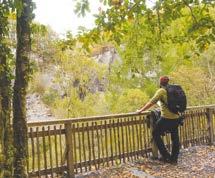
From small beginnings – a handful of pioneers digging the poor soil of a disused slate quarry, with a vision of abundance and a different way of life – CAT’s influence now spans the globe. The people who have been educated, empowered and inspired here have gone on to share what they have learned with others, expanding our impact exponentially.

The fruits of this living, breathing network of ours are popping up everywhere. They can be seen in the new hope of people and communities taking action on the climate and biodiversity crisis, despite increasingly bleak projections; the sustainability entrepreneurs daring to do business differently; and the councils showing national government what leadership towards net zero looks like.

Everyone in our community – students and lecturers, members and volunteers, donors and campaigners – is connected by our belief that a better future is possible. And our willingness to change the way we live our lives to get there.

The pages of your magazine are filled with stories of how, together, we are supporting people to share their passion, knowledge and skills with others, towards a safer, healthier and happier tomorrow. I hope you enjoy reading about Tyfu Dyfi boosting local food growing and composting, the CHERISH project exploring the impact of climate change on our coasts, and exploring the precious web of wildlife that has found a home at CAT.
Recognising our fundamental connection to the world and each other is the beginning of our efforts to build a world based on cooperation and care for one another. Thank you for being part of our community and helping to make so much possible.


 Eileen Kinsman, co-Chief Executive Officer
Eileen Kinsman, co-Chief Executive Officer

Clean Slate 3
EDITORIAL
xxKeep in touch Write to us: Centre for Alternative Technology, Machynlleth, SY20 9AZ Visit our website: www.cat.org.uk Be our facebook friend: Centre for Alternative Technology Follow us on twitter: @centre_alt_tech Read the CAT blog: www.cat.org.uk/news email us: members@cat.org.uk Give us a call: 01654 705988
Eileen Kinsman Everything is connected
CAT at 50
Since 1973, CAT has been helping people to channel their care for humanity and the wider natural world into positive action. From our Centre in Mid Wales, we’ve been educating, equipping and energising people all over the UK and beyond.
Back in the 1970s, it was already clear that ‘business as usual’ was no longer an option, as it would put humanity on a path to environmental breakdown. While this message was far from entering the public consciousness, a pioneering group of people who dared to think differently about how we could live our lives established the Centre for Alternative Technology.
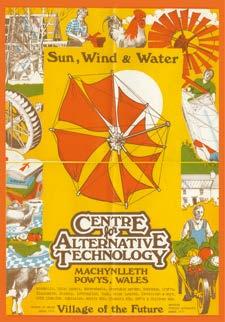
This community of committed volunteers, including engineers, architects, builders and growers, began developing, testing and sharing technologies and ideas that could help build a more sustainable society.
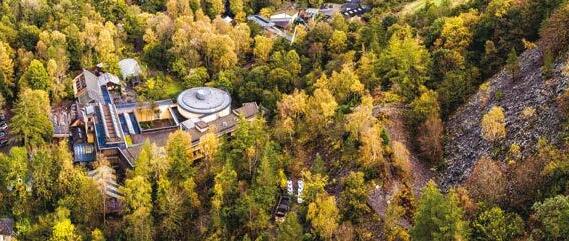
Now, in 2023 – as CAT turns 50 – we are looking back at our story so far and learning from our experience to drive the urgent action that’s needed over the coming months and years.
CAT simply wouldn’t be here without our inspiring network of
members and supporters. We would love you to join us in celebrating all that we have achieved together.
In this special anniversary year, we’ll be holding a series of events to mark five decades of sharing positive solutions to the climate and biodiversity crisis.
• In an exhibition at our visitor centre this summer, we’ll share photographs of CAT across the decades – from our inception to the present day.
• A summer open day will celebrate the big things we have achieved together.
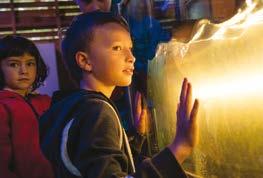
• And the return of the CAT conference will be an opportunity for us to celebrate with members.

As well as all this, we have a diary of events and activities planned throughout the year, both at CAT and online, for you to join us in marking CAT at 50.
You’ll be able to read much more about 50 years of CAT in the next issue of Clean Slate – a special anniversary issue.
4 Clean Slate CAT news
CAT's WISE education and conference centre, nestled amongst woodland on what was once bare slate. Inset: an early poster promotes the visitor centre as the 'village of the future'.
CAT provides a hub where people can come together and share knowledge and inspiration. Image shows delegates at a Zero Carbon Britain conference.
We've spent 50 years sharing solutions with visitors of all ages.
CAT conference returns
We are delighted to announce the return of the CAT conference this November. Join us for a weekend at CAT to celebrate 50 years of sustainable solutions. You'll be able to take part in talks, tours and workshops on a diverse range of topics, from renewable energy to regenerative growing. Our experts will be on hand to update you on the latest developments in their field. And you’ll be able to share your own knowledge, skills and stories with other CAT members from across the UK and beyond.
Save the date: The conference will run from Friday 10 to Sunday 12 November at our Centre in the beautiful Welsh mountains. The option of full-board accommodation will be available while we still have capacity.

To be first to hear when booking opens, sign up to news by email at cat.org.uk/sign-up and follow us on twitter and facebook for updates.
Finding inspiration in postcards from the future
Schoolchildren across Denbighshire have been imagining future worlds in a county-wide postcard design competition run in collaboration with CAT’s Zero Carbon Britain team.
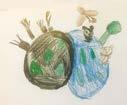

Denbighshire County Council invited pupils to think of themselves in 2050 and to send a postcard back in time to help inspire people to work together to take action on the climate emergency. Thinking about the changes that might have taken place, they were encouraged to explore what might have been done to combat climate change, as well as how weather patterns might have changed and the impact of this on their communities and the wider natural world.
A total of 350 entries were received from across the county, with four winners being chosen from different age groups.
CAT’s Head of Learning and Education, Amanda Smith helped pick the winning entries. She said: “The children’s hopes and fears for the future were extremely moving, with many postcard designs depicting the impacts of climate change on the natural world and others sharing messages of hope about what we can achieve if we work together to take action. Simple methods like postcards from the future can be a good way of talking about climate change with young people, encouraging them to discuss their anxieties about the future and to think about what changes we can make today to create a better tomorrow.”
The winning schools were Ysgol Caer Drewyn in Corwen, Ysgol Carreg Emlyn, Prestatyn High and Ysgol Tir Morfa in Rhyl. Each was presented with a selection of environmental books, a talk from the County Council’s Biodiversity Team and a collection of plants to help create or improve a wildflower area.
Join our BioBlitz
Looking for something wild to do this May half term? How about joining our BioBlitz and helping to survey the abundance of nature across our site?

A BioBlitz is a fun way for anyone to get closer to nature and learn more about how to help protect it. Your little naturalists will be given a specific area to focus on, racing to discover as many species of plants, animals and fungi as they can in the time they’re given. And they’ll be joined by wildlife experts to help them identify what they find. For more details, or to join in at home with your very own backyard BioBlitz, see page 17.
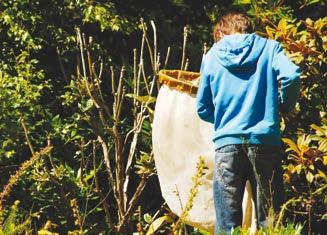
Clean Slate 5
Join us as we survey insects, pondlife, birds, mammals, amphibians, and more.
Take part in talks and discussions and share solutions with other CAT members.
One of the winning postcards, designed by Ysgol Tir Morfa pupil Macey, asked people to protect the Earth to give animals a better future.
Wales Net Zero 2035 Challenge Group
CAT’s Zero Carbon Britain Knowledge and Outreach Coordinator, Paul Allen, has been invited to join a group of independent experts that will help advise the Welsh Government on how Wales could accelerate action on the climate emergency.
The ‘Net Zero 2035 Challenge Group’ has been set up as part of a cooperation agreement between the Welsh Government and Plaid Cymru, and will examine potential pathways to net zero by 2035, looking at “the impact on society and sectors of our economy and how any adverse effects may be mitigated, including how the costs and benefits are shared fairly.” Wales is currently committed to reaching net zero by 2050.
Chaired by Dr Jane Davidson, the group is made up of experts from a range of universities, NGOs and public and private sector organisations, including University of Swansea, University of Wales Trinity Saint David, Public Health Wales, National Trust, Wildlife Trust Wales, Aldersgate Group and Siemens Energy as well as CAT.
The group held its first meeting in January this year and is expected to provide updates on its work between now and mid-2024.
Soil Symposium
Exploring Bold Futures
This year sees the launch of a new project designed to address climate anxiety in young people, helping them understand the causes and effects of global heating and what actions we can take to lessen and adapt to climate impacts.
During the spring and summer, we will be working with groups of young people from across the UK to co-create a range of future visioning activities. Including both facilitated workshops and self-led experiences, these will be designed to help people to explore positive futures and how we can make change happen. Once developed and tested they will be rolled out to visiting school, college and university groups, with self-led activities available to visitors to CAT.
A 2021 survey of 10,000 young people in 10 countries found that nearly 60% felt ‘very worried’ or ‘extremely worried’ about climate change, with 45% saying that these feelings impacted their daily lives. Future visioning can improve understanding of both the problem and the solutions, and help young people to see where they might influence change.
This project is funded through the ‘Bold Futures’ programme from the Association of Science and Discovery Centres, Museums Association and The
Liminal Space design consultants, and is supported by Wellcome as part of the Inspiring Science Fund.
Upcoming Graduate School open days
Our Graduate School Open Days are the perfect opportunity to find out if studying at CAT is right for you.
Attending an on-site open day will give you a taster of our courses and studying at CAT through an introduction and course overview presentations, tours, Q&As and course taster sessions. Meet programme leaders, support staff and CAT students and graduates during the day and find out more about studying with us.
Or join staff from the Graduate School on one of our virtual open days to find out more about studying on one of our postgraduate courses. Sessions last roughly an hour and a half and include an introduction to CAT and our courses and give you the chance to ask any questions you might have about studying with us.
Visit our website at cat.org.uk/opendays to see upcoming open days and events, or sign up for news by email. Whether you choose to visit us in person or virtually from wherever you are in the world, we can’t wait to meet you!
We urgently need to change how we think about and use the soil to ensure our food security and fight climate change.
As part of the Tyfu Dyfi project (see page 10), our Soil Symposium will be bringing together a range of experts and community composters to share their knowledge, skills and experience on protecting and restoring our soils. We’ll cover everything from microbes and fungi to creating the ideal blend of compost tea. There will be talks, tours, hands-on workshops, creative explorations and round-table discussions, all aimed at building our understanding and inspiring action.
• Soil specialist Richard Hartnup (see page 12) and other experts in soil, food and growing will join us to explore the the world beneath our feet.
• There will be a chance to meet some of the people involved in the Tyfu Dyfi community growing project.
• We’ll showcase some of our students’ work on soils.
Join us at CAT on 13 and 14 May to dig deep into soil.
Soil is one of our most precious non-renewable resources. While the dirt beneath our feet often gets taken for granted, it is home to thousands of animals, plants and other important organisms, and sustains all life on Earth. However, today, a third of the world’s soil is moderately to highly degraded.

• CAT’s gardeners will be on-hand to give advice.
• And if you’d like to bring the family, there will be activities for children too.
So, roll up your sleeves and keep an eye on our enews and social media for updates when booking opens.
6 Clean Slate CAT news
Shutterstock/maxbelchenko
UK's first dedicated natural fibre insulation mill opens
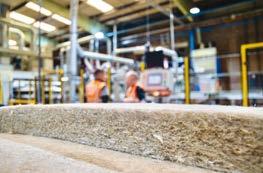

to reduce the negative impact of the construction sector on the environment and people’s health. Which is where our Graduate School of the Environment came in.
Scott said: “We’re delighted to finally have the ability to manufacture carbon negative and healthy insulation at scale for the future, drawing on traditional crops and building techniques.
“The world needs more sustainable construction materials like IndiTherm, with breathability to preserve buildings and create healthy indoor air quality reducing damp and mould, and that are great to work with and healthy for installers.”
IndiTherm flexible insulation batts are just the beginning for IndiNature. The company is now busy developing and manufacturing new insulation products, with thermal acoustic boards and its full IndiBreathe system to be launched later this year.
In December, IndiNature, a company founded by CAT graduate Scott Simpson, opened the UK’s first dedicated natural fibre insulation mill in the Scottish Borders.
From the new mill, Scott’s company is now manufacturing sustainable construction materials, made with hemp and crops from local farms, on an industrial scale. The first product off the line – IndiTherm – is now available from merchants throughout the UK.
Scott credits a large part of the success of IndiNature to his time at CAT. Previously working in grassroots local community development in Scotland and seeing the shocking housing conditions people were living in, he was motivated to learn how
Applications open to join CAT’s Board of Trustees
Our Trustees provide vital strategic oversight of our work, which has never been more important than at this time of urgent need to provide solutions to the climate and biodiversity emergency. Could you join them?
The Board is seeking expressions of interest in becoming a CAT Trustee from people with experience of data protection/cyber security and digital strategy, education or education strategy, or fundraising. Experience of capital fundraising campaigns, major donor fundraising, statutory funding, and fundraising from trusts and foundations would be especially welcome.
Alongside these more specialist skills, the Board is also looking for a broad complement of usual trustee skills, including commitment to the vision and mission of the organisation.
We would especially welcome expressions of interest from younger applicants, Welsh speakers, and people
from minority ethnic backgrounds.
You can find out more on our website at cat.org.uk/vacancies. If you’re interested and would like an informal chat with one of the current Trustees, contact theresa.lober@cat.org.uk
Applications open for student bursaries in 2023
CAT’s Graduate School of the Environment is once again able to offer bursaries to new students accepted to study with us from September 2023, thanks to generous donations from CAT supporters, members and charitable trusts.
For 50 years, CAT has inspired, informed and enabled people to take action on environmental issues. CAT students and graduates are making a real difference across industries and sectors, developing and implementing climate solutions and making positive change happen.
Today, our postgraduate courses on practical solutions for a sustainable
future are respected across the world. We aim for these courses to be as accessible as possible. Confronting climate change requires work on a global scale, with ideas and solutions coming from people from all backgrounds and disciplines.
Bursaries help us share climate solutions with an even wider and more diverse audience. The bursaries we offer ensure our courses are available to students who otherwise wouldn’t be able to study at CAT. They help them be inspired and gain knowledge to kick-start their careers as changemakers working in sustainability.
Applications for all bursaries are now open and will close in May 2023. Find out more about them and if you’re eligible at cat.org.uk/bursary
To find out more about applying for one of our postgraduate courses for 2023 entry, get in touch with our Graduate School Marketing Officer, Alis Rees, at study@cat.org.uk. We hope to see you at CAT soon.
Clean Slate 7
Up Here Media
The new mill manufactures carbon-negative insulation materials made from UK-grown hemp.
IndiTherm is the first product off the line – with more being launched later this year.
Sharing Mindsets and Missions
engage audiences with the relationship between climate change and land cover.
The project brings together 30 museums and science and discovery centres from across the UK with 15 creative practitioners, researchers and experts, combining both lived and learned experience to stimulate collaboration and peer learning.
CAT has been awarded a place on a new learning and grants programme that supports museums and science centres to engage underrepresented groups with knowledge, research and innovation.
Using the concept of ‘future citizens’, the Mindsets + Missions programme will explore strategies to reach new audiences and to enable people from diverse backgrounds to engage with, influence and participate in the creation of positive futures. CAT’s project will draw on our partnership with Aberystwyth University’s Living Wales project to
CAT’s Head of Learning, Amanda Smith said: “One of CAT’s core values is a belief in the transformative power of diversity, inclusion and equality. Only by actively engaging different perspectives can we challenge and stretch our thinking and empower people, policy makers and organisations to make the radical changes that we need to deliver a sustainable and regenerative future. We are excited to be working with this group of organisations and individuals to explore how we can better connect with underrepresented groups as we work together to address the climate and biodiversity emergency.”
Mindsets + Missions is funded by UK Research and Innovation (UKRI) in partnership with the Arts and Humanities Research Council (AHRC), the Museums Association, The Liminal Space and the Association for Science and Discovery Centres.

Climate change and our coastline – an exhibition
From 9 May until 18 June 2023, you can visit the CHERISH travelling exhibition at CAT. CHERISH, which stands for climate, heritage and environments of reefs, islands and headlands, is a multidisciplinary project exploring the impact of climate change on our fragile coastal heritage.

Included in the bilingual exhibition will be data from the
project – including lidar imagery, laser scan data and drone photography – and artistic responses to the science from poet and geographer Hywel Griffiths, and Mid Wales-based artists Julian Ruddock and Pete Monaghan.
Take a look at Hannah Genders Boyd's article on pages 20-22 for more on the CHERISH project.
8 Clean Slate CAT news
The new exhibition will explore the impact of climate change on the coastal heritage of Wales and Ireland.
SHORT COURSES SPRING/SUMMER 2023
April 2023
1 – 2 Building Natural and Healthy Homes
18 – 19 Zero Carbon Britain: Carbon Literacy for the Housing Sector
22 Renewables for Households: Wind Turbines
22 Compost Toilets
23 Reedbeds and Waste Water Management
22 – 23 Introduction to Bees and Beekeeping
May 2023
2 – 3 Fixing Your Damp House
5 – 8 Build a Tiny House
9 – 10 Zero Carbon Britain: Carbon Literacy for Communities

13 Renewables for Households: Heat Pumps
20 – 21 Building Natural and Healthy Homes
27 Renewables for Households: Solar PV
June 2023
2 – 5 Build a Tiny House
2 – 5 Eco Refurbishment
17 Renewables for Households: Solar Hot Water
24 – 25 Cob Building
July 2023
1 – 2 Introduction to Bees and Beekeeping
21 – 24 Build a Tiny House
August 2023
5 – 6 Building Natural and Healthy Homes
5 – 6 Build a Small Wind Turbine
12 Compost Toilets
12 – 13 Cob Building
13 Reedbeds and Waste Water Management
21 – 25 Building with Straw Bales
courses are being added all the time – please see our website for up-to-date listings.
out more and book your place online at cat.org.uk/short-courses or call us on 01654 705950
More
Find
Growing the relationship between food, nature and wellbeing in the Dyfi Valley
interdependencies and large numbers of people. On the supply side, there is a national shortage of people who know how to grow vegetables, grains and fruit without agrochemical inputs.
On a well-tended half-acre field on the CAT site, Tyfu Dyfi is helping to address this skills gap, with partner organisation Mach Maethlon providing horticultural training to help people make a living from local food production. Over two years, 23 trainees have been through the programme, with many going on to work in market gardens in the area, or growing their own produce for sale to local markets.
The flagship output from the project is the network of new and enhanced community growing sites in residential areas across the Biosphere. Working with Garden Organic, Tyfu Dyfi has funded everything from new raised beds and ponds to training, to help stimulate interest, impart skills, educate and provide opportunities to get growing.
Tyfu Dyfi, bwyd, natur a lles (Dyfi Growing, food, nature and wellbeing) is a project aiming to boost the local food economy, get a broader demographic involved in growing, and advance the sustainability agenda in the Dyfi Biosphere, Wales’s only UNESCO designated biosphere reserve.
The project recognises that food and farming are fundamentally important in addressing the climate and biodiversity crisis. Taking into account the full range of food and farming-related activities – including land use, refrigeration, transport, and so on – this accounts for approximately one-third of global greenhouse gas emissions, while agricultural sprawl is the main cause of species extinction worldwide.
Agroecological approaches
Food systems are complex, multidimensional and politically sensitive – everyone has an opinion on what we should eat. In response to the impacts of the dominant industrialised food and farming system, agroecological
approaches call for system change and addressing the social dimensions and power imbalances that many argue are at the heart of the problem.
The key concept of agroecology is that there is no genuinely sustainable food production without intact biodiverse ecosystems. We need these to benefit from the goods and services they provide: soil formation, pollination, pest control, nutrient cycling, water purification, and so on. Socially, the emphasis is on farmers’ knowledge of the land they work, solutions adapted to local conditions, local economies, and short supply chains.
Tyfu Dyfi explores this through a ‘think global, act local’ approach. Led by local development trust Ecodyfi, the twoyear project brings together a consortium of seven partners: CAT, Mach Maethlon, Garden Organic, Aber Food Surplus, Aberystwyth University, and Penparcau Community Forum.
Getting people growing
Transitioning to a sustainable food system involves complex
In a rural area such as this, there is obviously much greater potential for increasing the supply of local produce by involving the farming community. Consequently, we have enabled experimentation and funded a series of field-scale trials of diverse crops, including fava beans, naked oats, potatoes, comfrey, swedes and no-till wheat.
No such thing as waste –two composting initiatives
There is no such thing as waste in nature. With support from CAT, we have established two community composting initiatives in and around Machynlleth. The first is in a rural setting, and will showcase the potential for circles of rural enterprises to pool resources, organise and turn low-value natural harvest resources such as bracken and rushes into valuable and much-needed compost. The second is in an urban setting. Local bus company Lloyds Coaches has allowed us to use a corner of its coach park to show what’s possible when the community gets behind an electric cargo bike collecting food waste from cafés and shops to feed a large in-vessel composter.

10 Clean Slate
Chris Higgins looks at the experience of the CAT-supported Tyfu Dyfi project, which has brought together a local community around growing and sourcing food in harmony with nature.
Fin Jordao with one of the new community composters, which turns waste into rich compost for local growers.
Appreciating local produce
On the demand side, we have turned to technology to help us increase the market for local produce, using the Open Food Network software. Hosted by project partner Aber Food Surplus, Bwyd Dyfi Hwb is a trading platform designed for small community food enterprises to sell directly to customers.

In tandem, we are expanding the use of the Biosphere’s own brand – Blas Dyfi Taste – to foster an appreciation of local produce and help with marketing and promotion.

Education is a theme that runs throughout the project, and we have run several community growing and cooking events, including at local schools.
Food in harmony with nature
As the project draws to a close in June this year, there are still hurdles to overcome. With the playing field heavily tipped against small values-driven food enterprises, the only way to mount a serious challenge is for the local food ecosystem to organise and reduce their costs by coordinating on price, deliveries, collection and distribution. This requires leadership and funding. And it needs to be much easier for large numbers of people to work cooperatively to produce food in harmony with nature.
In the last few months of the project, we will be making it easier for anyone in the Dyfi Biosphere who wants to get involved in growing their own food or supporting local producers.
Find out more
If you happen to be in the area on 27 May 2023, come along to Gwyl Fwyd a Thyfu Biosffer Dyfi (Dyfi Biosphere Food and Growing Festival) in Machynlleth, and find out more about the project, or
Closed loop community composting: a circular economy case study in the Dyfi Biosphere – Fin Jordao
People and communities everywhere are looking for tangible ways to work together to make positive steps towards the future they want to see. Community composting is one such initiative – an example of the circular economy at its elegant best: reducing transport emissions and harnessing biomass resources to support soil regeneration and local food production.

Food waste is a big problem; composting can become a big solution. Food growers need access to good compost regularly and in large amounts. While kerbside collection boosts recycling numbers and might create gas for the grid, only decentralised initiatives generate compost for local growers to feed crops. This is why local schemes are popping up around the country and all over the world.
Here at CAT, we’ve been sharing our composting expertise to help set up a new community composting service in Machynlleth and a training programme spanning the Dyfi Biosphere. The service is now run by Criw Compostio, an independent community enterprise that is offering a kitchen caddy collection service powered by electric cargo bike to a new food surplus project, food businesses and landscapers. It aims to be an example of managing degradable waste – bracken, sheep wool, woodchip, grass clippings, food scraps – locally. In Criw Compostio's words, ‘If it rots, we will take it.’
Fin is CAT’s Water Officer, Ecological Sanitation Educator, and Co-Director of Criw Compostio.
join us for the Tyfu Dyfi Soil Symposium at CAT on 13-14 May – see page 6 for details. CS
About the author
Chris is part of the Ecodyfi team, with responsibility for project managing the Tyfu Dyfi project, helping to make the Dyfi Valley a thriving, healthy, caring place that is renowned for sustainable living. He has degrees in Ecology, Information Technology and Geographic Information Systems.
The Tyfu Dyfi project was made possible by support from the Welsh Government through the Enabling Natural Resources and Wellbeing (ENRaW) programme, with funding from the European Agricultural Fund for Rural Development (EAFRD).

Clean Slate 11
A kitchen caddy collection service uses an electric cargo bike to gather food scraps and other biodegradable waste from local businesses, ready for composting.
Worming through the soil
Retired Environment Studies lecturer and soil specialist Richard Hartnup explores the wonder and complexity of the ground beneath our feet and invites us to take a new perspective on the very foundations of CAT.
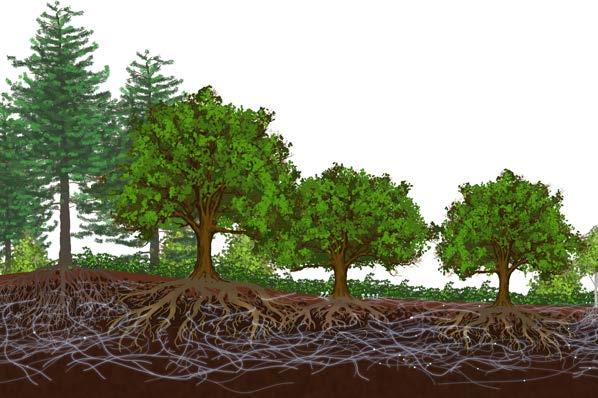
sparse resources of the old quarry. I’m pretty sure their methods have been documented, but I suspect their gentle and intelligent approach involved working with nature, rather than against it.
covers the skeleton that it is imbued with life – and what rich and varied and interconnected life!
From the start, the visionary pioneers of CAT regarded soil as a living entity. People came from all over the world to live a simple, sustainable life in an unpromising slate quarry. They worked hard, quietly and effectively, developing the kinds of green energy that are now mainstream. They may have helped save our planet. But what amazed me as a soil specialist was that they created real and complex productive living soils from the
Studying the growth of soils on abandoned land – especially if it’s raw rock – teaches us that soils take a very long time to mature, measured in hundreds of years. I’m old enough to have seen large trees form woodlands in the long deserted chalk quarries in Kent, where I used to play in the grassland and scrub. In the shelter of the quarries, the trees are not readily blown over, despite the shallowness of their soils. Each year, decaying leaves and fallen branches add a little more to the soil, while roots break up the mineral substrate, very slowly converting rock and stones into subsoil.
The colonisation of slate waste and the slow creation of soil begins with fungi, lichens, mosses and algae that invade the rock surfaces and soften them up with a variety of biological chemicals. Once larger mosses get established they begin to form a humus covering, which thickens as the decades go by, especially in crevices, which get wider as grasses and shrubs begin to come in. Eventually, the rock breaks down into those familiar soil particles: stones, sand, silt and clay, sometimes called the soil mineral skeleton.
So far, so mundane. It's when the right variety of flesh
The plant remains of the living things that have helped create the soil attract an abundance of large and small animals, some of whom burrow through it, mixing it intimately with the minerals. They poo in the soil, and their casts and droppings are feasts for another suite of animals, fungi, plants, slime moulds and bacteria. Some organisms excrete sticky substances that glue soil particles together, creating crumb-like aggregates or blocks. Rain sends water through the body, washing substances down into lower layers. The pores and tunnels made by creatures, and the cracks that appear as wetted soil dries out are filled with gasses similar to air, but with extra carbon dioxide, water vapour and organic gasses produced by the decay of organic matter.
And then, of course, there are roots, large and small and hair-like. The roots are in close connection with fungal strands that form a wide-ranging transport and communication system within the landscape that makes the London Underground look like a primitive wooden train set.
Despite a working life, at least 40 years, of dealing with soil, it’s only since retirement that I’ve come to realise just what truly amazing stuff it is. It doesn’t run around like a mammal or fly like a bird, it’s not showy or particularly colourful, in fact, it is usually out of sight; but evidence is mounting that its
“It is enough
To smell, to crumble the dark earth, While the robin sings over again Sad songs of Autumn mirth.”
12 Clean Slate
Digging, Edward Thomas
extraordinary complexity and variety sustain life in ways that are far more intricate and important than we ever thought. Many serious and scientifically credible researchers even think the almost invisible fungal communication systems that explore the maze of pinpoint pores and tiny tunnels beneath our feet are the equivalent of neural networks and sense organs in the animal world, and that their intimate continuity with plant tissues enables a form of communication between plants that we can only vaguely begin to comprehend.
Soil is part of us, and we’re part of it.
To quote Aldo Leopold, the famous author, philosopher, scientist and conservationist: “Land is not merely soil, it is a fountain of energy flowing through a circuit of soils, plants and animals.” In short, land and soil are living things. Their infinite variety is fascinating, beautiful and awe-inspiring.
Nowadays, much is claimed for the essential activities of soil-based networks of fungi in woodland. The much-loved mushrooms that we enjoy in autumn are simply the fruits – the reproductive parts of the beast; fungi are as different from plants as animals and plants are from each other. The bulk of the fungus, its mycelium , lies hidden underground, where strands as fine as the finest roots spread in all directions, with many of them making vital links between trees and other plants by intimate and interlinked connections with their roots. Fungal strands are able to absorb minerals that plant roots can’t, and deliver them to the trees. In return (as it were) the trees give sugars – the products of photosynthesis – to the fungi.
But the relationship is much more than this. It has been demonstrated that – as well as dissolved nutrients – chemical and probably electrical signals are carried by the fungal network from tree
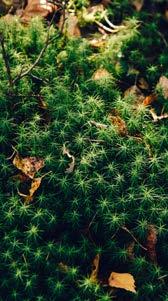
to tree, allowing them to warn each other of insects and other predators. It would be strange if herbs, grasses, ferns and the like were not also involved in these beneficial exchanges.
What’s more, some mature trees, using the subterranean network of fungi, are able to preferentially provide their own seedlings and saplings with nutrients to nurture their early development. Other trees will supply trees of different species with extra nutrients at times of hardship, and are repaid later, so there’s a kind of arboreal subterranean social security system going on.
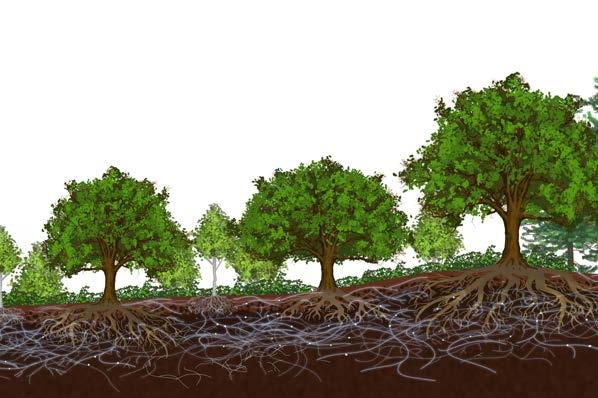
Some highly respected scientists believe that there is a kind of group consciousness of which this eco-web is an essential part, since, to put it simply, the wood-wide web acts in a manner spookily similar to a nervous system, or the neural networks being developed by designers of artificial intelligence. See, for example, Ways of Being by James Bridle, Finding the
Mother Tree by Suzanne Simard, and Entangled Life by Merlin Sheldrake.
James Bridle points out, with convincing arguments, that our own intelligence represents only one way of interpreting the environment in which we find ourselves. The multiplicity of life on earth has evolved many other effective strategies for survival. While Darwin and Wallace emphasised competition and ‘survival of the fittest’, mountains of evidence have shown that cooperation for mutual benefit has also played an important role in evolution. Individual organisms are part of cycles within communities of other species. What is good for the community is good for the evolving individual, and this applies to the entire biosphere.
The soil is a sophisticated and long evolved product of these interactions. It is complex, exciting and beautiful in its own right. More than this, soil development has accelerated the earthly conditions that enabled the evolution of mammals and our own species. It is because of soil that we can enjoy the superb green landscapes and sustaining environment of Wales with its glorious green forests, fields, wild wetlands and waters. CS
About the author
Richard worked for many years for the Soil Survey of England and Wales. He left in 1990 to lecture in Environment Studies in the Lifelong Learning department of Aberystwyth University. Now retired, his interests are photography, botany and interpreting the Welsh landscape. His book on the soils and landscapes of Wales, Gold Under Bracken, is published by Y Lolfa press.
Clean Slate 13
CAT Wild
Dormice
Over the past five decades the CAT site has been transformed from a scarred post-industrial landscape to a variety of rich habitats that make it an ideal home for a wide range of species. It is a living example of how we can step in and help bring nature back from the brink. Meet some of the species that have found a home at CAT, and find out more about the habitats and ways of working that have helped nature and people thrive together in what was once a disused slate quarry.
Lesser horseshoes
In Britain, the hazel dormouse population has fallen by more than 50% in the past 20 years and the species is considered to be vulnerable to extinction.

Loss and fragmentation of ancient woodlands, reduction in traditional forestry methods, and the impacts of climate change are amongst the threats to this much-loved mammal.
Dormice are creatures of the forest canopy; they benefit from a diverse woodland understory where they can nest, feed, and raise their young. They rarely come to ground, and won’t venture across large, open spaces, making them particularly impacted by the loss of connectivity between woodlands. Added to this, climate change is disrupting their hibernation cycle, with milder winters making them more likely to wake up earlier or more frequently. Waking prematurely, when their food is scarce, can lead to starvation.
CAT’s Quarry Trail includes an area of coppiced hazel trees dedicated to our resident dormice. Hazels provide a great source of fatty nuts and well-linked branches that act as pathways, while climbing plants like ivy and honeysuckle create good links between the shrub and canopy layer as well as offering additional habitat. With the help of our amazing volunteers, we have also built and installed nest boxes to provide warm, dry nesting spaces.
Pine martens

Once one of Britain’s most common carnivores, a combination of loss of woodland habitat and persecution saw the pine marten on the verge of extinction in England and Wales. Legal protections and habitat conservation in the late 20th century saw a recovery in the Scottish Highlands, but surviving pockets in England and Wales continued to struggle. A programme of managed reintroductions in Mid Wales and the Forest of Dean is now helping bring them back from the brink.
One of 51 pine martens introduced into Mid Wales between 2015 and 2018 is now a very welcome visitor to the CAT woodlands, making regular appearances on camera trap footage. Recent sightings of young pine martens in nearby woods have provided further evidence that they are making themselves very much at home.
Pine martens rely on well-connected, diverse woodland for food, shelter and to raise their young. We’re working hard to improve their chances through careful woodland management, planting more native trees and maintaining a well-developed ground and shrub layer. Our woodland provides natural dens in the form of retained deadwood and old trees, and we’ve added den boxes to give them an extra helping hand.
Lesser horseshoes are native, rare and endangered, with falls in populations attributed to starvation caused by declining insect numbers and loss of foraging habitat such as shrubland, open grassland and woodland edges.
Sensitive habitat management is vital to their survival and recovery, as is protecting and improving roost sites and surrounding areas.
Here at CAT, we have an established roost in the basement of one of our buildings. It is an ideal spot, being undisturbed with a clear access point that allows continuous flight. Minimal external lighting and sensitive habitat management is key – the CAT woodland team uses traditional methods to manage broadleaved woodland, ponds, hedgerows and tree lines.
We have recorded no less than six species of bat at CAT in recent years, including a fleeting visit from a greater horseshoe – one of only a handful of sightings in Mid Wales – pointing to the tantalising possibility of a nearby summer roost.

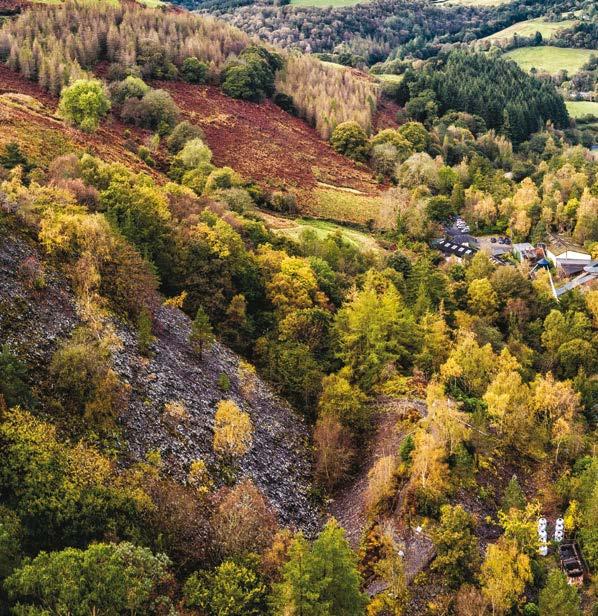
Otters
Otters are seen as one of the great British conservation success stories. Having been on the verge of extinction in some areas in the 1950s-1970s, largely because of habitat destruction and river pollution, they can now be found in almost every county. However, recent surveys in Wales have rung alarm bells, with an unexpected decline in numbers being blamed on pollutants from industry, farming and wastewater treatment.
Here at CAT, we have spotted otter activity both in the river that runs past the visitor centre and on the site itself, leading our woodlands team to offer them a helping hand with an artificial otter holt. Alongside sympathetic management of riverine and aquatic habitats, we hope this holt will provide a safe haven for otters to raise their cubs on the banks of the Afon Dulas for many years to come.
 Shutterstock/BMJ
Shutterstock/BMJ
Mark M e d c a l f Shutterstock / Mic h a P e s ta a
Shutterstock/
ken uB r i v a
ybZ/kcotsrettuhS
Spotted flycatchers
Numbers of these summer visitors to the UK have dropped by 90-94% since the 1960s, and the spotted flycatcher is now on the UK ‘red list’, meaning it is one of the birds in most need of our help. A number of factors may be contributing to this decline, including falling insect numbers, habitat loss in their African wintering grounds, difficulties on the migration route, climate change, and increased nest predation. Changes in woodland management practice in the UK may also be adding to the problem.

Visitors to CAT from May to September may be lucky enough to catch sight of a spotted flycatcher – last year we had two nests on site, including one in our woodland workshop.
Hawfinch
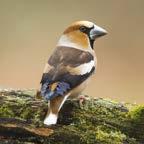
The British hawfinch population is thought to number fewer than 1,000 breeding pairs, and it is another UK red list species, so we see it as a real privilege to spot them in the forest canopies around CAT.
Our woodland management plans include providing a varied structure of understorey of shrub for hawfinch, as well as creating wet features to provide them with plenty of water. We retain ivy and other creepers to provide crucial nest cover. We also think ahead, planting trees now that will provide suitable habitat for future generations of hawfinch and many other species.
Education and training
As an educational charity CAT’s key focus is on sharing knowledge, skills and inspiration to help people explore and implement solutions to the climate and biodiversity crisis.
It is a delight and a privilege to share our site with so much rich biodiversity, and the fact that all of these struggling species can thrive on what was once bare slate provides a living example of how people can work with nature to help species back from the brink.
Visitors, school and college groups, university groups, people on short courses and postgraduate students all get the chance to learn in an environment that brings solutions to life and shows what’s possible. We also offer courses specifically aimed at helping increase skills and knowledge in the areas of ecology and habitat management. Our gardening for wildlife experience days help people see what they could do in their back garden or community green space. Our Sustainable Woodland Management short courses help people get to grips with how to manage woodlands in ways that are both economically productive and ecologically beneficial. Masters degrees in Sustainability & Ecology and Sustainable Food & Natural Resources provide a deeper understanding of issues and solutions, with many of our graduates going on to work in conservation and wildlife engagement, or taking their studies further with PhD research.
Find out more about our courses and teaching activities at cat.org.uk/ courses-and-training
Regenerative redevelopment
As we make plans for an inspirational new visitor experience and sustainable skills hub at the CAT eco centre, we’ve been taking a closer look at some of the plants and animals that share our site, and exploring how our redevelopment plans can allow us to go even further in protecting, enhancing and restoring nature.
The aim is not just to create more space for wildlife on our Mid Wales site, but to share learnings through our education and training work, and to be a showcase for regenerative design, inspiring others to plan developments in ways that put people and the wider natural world at the very heart of their work.
If we hit our fundraising targets this spring, we plan to commission specialist surveys and advice to build up a more detailed picture of the biodiversity of the CAT site, to develop a richer understanding of our habitats, and to begin to sketch out how we can best support what’s already here as well as making space for more. Look out for updates on what we find and how plans develop in future issues.

Crown CopyrightCentre for Alternative Technology
Shu t t e r s t o c k / Clra D a y
Shutterstock/Erni



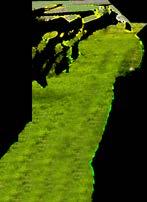

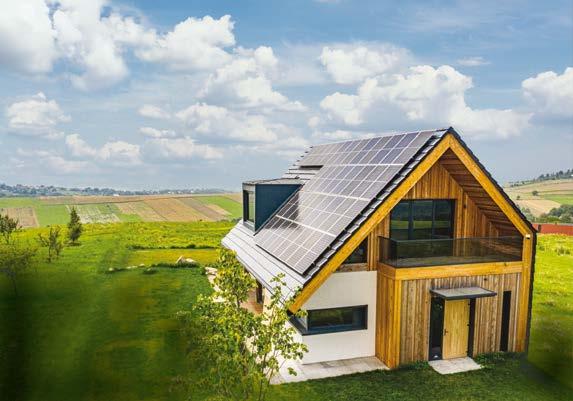










www.ecomerchant.co.uk info@ecomerchant.co.uk 01793847444 LOW-IMPACT,NATURAL ANDECO-FRIENDLY BUILDINGMATERIALS Dedicatedtomakingethicallysourced, sustainablebuildingmaterials accessibletoall,ataffordableprices. Helpingyoutocreatehealthy,energyefficienthomes,schoolsandworkplaces. Callandspeakwithoneoftheteamor browseourfullrangeofproductsonline. UK-widenextday/standarddeliveries. Architects designing beautiful, comfortable, sustainable buildings. Specialising in new build and retrofit homes to Passivhaus standards. 01908 886854 www.ecodesignconsultants.co.uk info@ecodesignconsultants.co.uk www.indinature.co UK Grown & Made Net Carbon Storage Vapour Breathable Competitive Pricing Soft to the Touch & Healthy UK Hemp Fibre Insulation
Join our Bio B L T I Z
This May half-term, we’ll be running a BioBlitz and inviting you to help survey the abundance of nature across our site. If you can’t make it to CAT, you can still join in, with your very own backyard BioBlitz.
A BioBlitz is a fun way to better understand the variety of wildlife around us. Focusing on a specific area, it involves a quick survey to discover as many species of plants, animals and fungi as possible. Anyone can get involved, from scientists and ecology students to families and groups of friends.
At CAT’s BioBlitz, our volunteers will be joined by wildlife experts to help them identify what they find. But if you’re carrying out your own survey, a good ID guide or app, such as iNaturalist, can be all you need to recognise the species near you.
By taking part in this scientific survey, you can become more aware of the nature on your doorstep and what you can do to help protect it. As well as investigating your own outside space, you could get your neighbours involved too, or even work together to survey the whole street, block or your local park. This can give you a good picture of what’s going on in your area and help make your community more wildlife friendly.
For example, hedgehogs love joined-up gardens as they can move around more freely to find things to eat and places to sleep. If you discover you’re lucky enough to have hedgehogs in your garden, perhaps you and your neighbours could make small gaps in your dividing walls, fences or hedges, so these endangered creatures can travel about.
Take a look overleaf for more ideas for helping wildlife where you are – if you’re already doing what you can, why not share these tips with friends, neighbours and colleagues?
How to do your own backyard BioBlitz
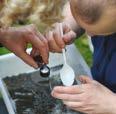
1. Decide where to carry out your survey, who to invite, and how long to do it for. Some people do a 24-hour BioBlitz, so they can see and hear their wildlife neighbours at all times of the day and night; other people see how much they can spot in an hour.
2. Define the area you are going to explore – is it a whole park or garden, or just one section of it? This will usually depend on how much time you have for your BioBlitz and how many people are helping.
3. Start spotting! You might want to focus on specific areas in different ways. Are there pollinators buzzing around the flower beds? Are there beetles and woodlice underneath the log pile? What birds can you spot if you sit quiet and still for a few minutes?
4. Record what you see and photograph it using your phone. Use a guide, such as iNaturalist or printed field guides, to help you identify the species you find. Remember to make a note of who made the sighting, your location, and the date and time.
5. After your BioBlitz, log your findings online at www. ispotnature.org to make your contribution to the big picture of nature in the UK.
6. Can you do this at least once every season? If so, you’ll start to build up a good understanding of the plants and animals that share your space, allowing you to think about how best you might help them to thrive throughout the year.

With more than 40% of UK species having decreased since 1970, according to the 2019 State of Nature report, we must act now on the biodiversity crisis. A BioBlitz is one way to do something positive for nature and help to make a difference. CS
Want to join CAT’s BioBlitz on our site in Mid Wales?

CAT’s BioBlitz
Where : the CAT visitor centre and Quarry Trail
When : May half term, 29 May – 2 June, with activities daily
Who can join us : activities are suitable for all ages, under 16s must be accompanied by an adult
What to wear : we’ll be outside, so dress for the weather
What to bring : all equipment and ID guides will be provided, so just bring your curiosity and love of nature!
Let’s get BioBlitzing! We can’t wait to see what you discover.
Clean Slate 17
Swifts are struggling, with UK numbers having fallen by more than 50% in the past 30 years. Give them a helping hand with a swift nest box – if you’re lucky they’ll return year after year.
Decorative window stickers can prevent birds from flying into glass windows and doors.

Growing plants that flower at different times of year is a great way to ensure pollinators and other insects don’t hungry. A window box may seem it can provide a much-needed pit Bug hotels come in all shapes and sizes, so they can be made to work in any space, providing safe hideaways for ladybirds, bees, spiders, woodlice, and more.
Nocturnal creatures can be confused artificial lights. Closing your curtains turning off lights in rooms you’re not is an easy fix.
Climbing plants can turn a bare wall into a great shelter for insects and birds.
Frogs and toads can easily fall into drains. Installing a drain guard is an easy way to stop them from getting stuck.
A water butt will save water and ensure a plentiful supply of rainwater for filling ponds and birdbaths.
Long grass provides shelter and hiding places for many different species so leave the lawn mower in the shed and let it grow.
Hedges allow animals to pass through a source of food, shelter and protection your garden has a fence or wall, can help hedgehogs and other small speak to your neighbours about
Avoid using weed killers and slug pellets as these can be harmful to wildlife.
Hedgehog home
18 Clean Slate
different ensure don’t go seem small, but pit stop.
Making space for nature
Whether in a window box, a balcony, a garden or a community green space, there are many ways to help the wildlife on your doorstep. Take a look at some of our quick tips.

Colourful nectar-rich flowers are a lifeline for bees, butterflies and other insects. Does your local park have space for a community wildflower meadow? Could you talk to your local council about what might be possible?
Bird feedersremember to clean these regularly to stop the spread of disease.
Bird boxes, bat boxes and hedgehog homes can provide invaluable roosting and nesting spaces. Different bird and bat species like different shapes and sizes so once you know who’s visiting the area you can create boxes that suit their needs.
through as well as providing protection from predators. If wall, adding a 13cmx13cm hole small mammals. Why not about doing the same?
Let the edges go wild. Shrubs, brambles and so-called weeds like dandelions, nettles and teasel are a great source of food and shelter for insects, birds and small mammals.
Piles of logs, trimmings and leaves can be a great hiding place for insects to live, and a good spot for hibernating hedgehogs and reptiles if undisturbed.
A pond – no matter how small – can be a lifeline for wildlife, providing a home for amphibians and insects and a place for birds and hedgehogs to stop for a drink.
confused by curtains and not using
Bat box
Rocks for habitat
Compost bin
Bee hotel
rainwater
The climate crisis on our coastline
Hannah Genders Boyd introduces the cross-disciplinary CHERISH project, aiming to raise awareness and understanding of the impacts of climate change on the rich cultural heritage of the coasts of Wales and Ireland.

As we all know, the global climate is changing. Global temperatures have risen by more than 1˚C since 1850, which has had noticeable impacts on our planet. Glaciers are melting quickly, and average sea levels have risen 16 cm between 1902 and 2015.
In the UK and Ireland, we expect to experience warmer, wetter winters and hotter, drier summers. Extreme weather events, such as intense rainfall, droughts and storms, may happen more often.
These predicted changes will have a variety of effects on our coastal heritage, including coastal erosion and damage to buildings from increased storm surges, flooding and landslides during periods of higher rainfall, and increased risk of destabilisation and collapse of driedout cliff faces during our hotter, drier summers.
The CHERISH project
This summer, a travelling exhibition at CAT will highlight these issues and impacts, exploring the work of CHERISH, a six-year EU-funded project that aims to raise awareness and understanding of the past, present and near-future impacts of climate change on the coastal heritage of Wales and Ireland. CHERISH is an acronym that stands for ‘climate, heritage and environments of reefs, islands and headlands’. The cross-disciplinary project brings together the Royal Commission on the Ancient and Historical Monuments of Wales; the Discovery Programme, Ireland; Aberystwyth University: Department of Geography and Earth Sciences; and Geological Survey Ireland, and was made possible thanks to €4.9 million of EU funding through the Ireland Wales Co-operation Programme. The project
began in January 2017 and will run until June 2023.
New insight into our past and future
CHERISH links land and sea, employing a variety of techniques and methods to study some of the most iconic coastal locations in Ireland and Wales. These techniques range from terrestrial and aerial laser scanning, geophysical survey and seabed mapping, through to paleoenvironmental sampling, excavation and shipwreck monitoring.
Data produced by the project has given us a new understanding of how climate change is affecting specific sites on the coasts of Wales and Ireland. For example, a key driving factor behind the coastal erosion seen at Dinas Dinlle hillfort in Gwynedd is increased precipitation (see box overleaf), while increased storminess
20 Clean Slate
An archaeological excavation supported by CHERISH on the eroding isthmus at Caerfai Iron Age promontory fort, Pembrokeshire.
and increasing numbers of extreme weather events is the biggest risk to Dunbeg fort in County Kerry. Understanding how climate change is affecting these sites, and creating baseline data for future monitoring, is important for knowing how to manage our heritage. We need to know what information is being lost, and how long different sites have left. Recording sites, for example through laser scanning or photogrammetry, creates a record that can be used by future researchers. This is particularly important if catastrophic loss occurs at a site, which may happen during an extreme weather event. Retaining archaeological information is an important aspect of our collective response to the climate crisis. as we move into an uncertain future, where our society will face new and unforeseen challenges. Climate Heritage is an intersectional discipline including archaeologists, geographers, climate scientists and archivists. It has been described as “packing a cultural
suitcase”: in the face of change and destruction, what do we save? This is not about protecting sites using hefty physical interventions – it’s about gathering knowledge while we have the opportunity, and employing that knowledge effectively.
Palaeoenvironmental research
Another important aspect of the CHERISH research has been gaining a long-term perspective on climatic change using palaeoenvironmental research.
Information on the nature, timing and rates of past environmental change provides a valuable long-term perspective for understanding current and future impacts of climate change. Physical, chemical and biological analysis of sedimentary archives help us to build up a picture of both regional climatic variability and local environmental change.
An important aspect of palaeoenvironmental research is the ability to accurately determine the
Climate projections and coastal heritage
Predicted climate change will have a variety of effects on our coastal heritage, including:

• Warmer global temperatures will lead to rising sea levels, impacting all aspects of coastal heritage as a result of flooding and storm surges.
• A rise in sea temperature bringing new marine species and pests affecting underwater and intertidal heritage.
• Hotter, drier summers may lead to the drying out of cliff faces increasing the risk of destabilisation and collapse affecting heritage sites on the coast. However, they could also lead to the discovery of new heritage sites visible as parchmarks and cropmarks.

• Warmer, wetter winters could lead to the ground becoming saturated, increasing the risk of flooding, landslides and erosion at heritage sites.
• More frequent extreme weather could create turbulent seas damaging heritage on the seabed and foreshore; cause erosion and loss at the coast edge from wave action; and cause structural damage to buildings.
timing of climatic or environmental change in a sediment record, or the age of an artefact or archaeological feature. CHERISH routinely employs two different techniques to provide the dating framework for sedimentary sequences and archaeological investigations: radiocarbon dating and luminescence dating. The combination of these approaches means that we can date a greater variety of sample types and contexts. Where both techniques can be used, this provides a valuable opportunity for cross-validation of age estimates.
The CHERISH project is focusing on sediment sequences that have the potential to provide records of past storm activity, extending back over thousands of years, such as coastal peat bogs, backbarrier lagoons and dune systems. These have been sampled by taking cores at research sites in both Wales and Ireland.
Understanding the dates for past storm events, sea level changes, ecosystem changes, growth of woodlands or peatlands, settlement growth or abandonment, and other dynamic elements of a landscape, allows us to build up a picture of human-environment interactions through time. Adapting the
Clean Slate 21
A map illustrating the CHERISH project study sites.
Coastal erosion driven by increased rainfall at Dinas Dinlle coastal hillfort in Gwynedd.
environment, and adapting to environmental change, have been part of the experience of coastal communities for many thousands of years. As we move into a future of rapid change, how do we continue to respond and adapt? What lessons for the future are buried on our vulnerable coastlines?
Investigating climate impacts at Dinas Dinlle
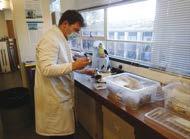
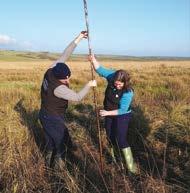
The prehistoric coastal fort of Dinas Dinlle, situated near the south western entry to the Menai Straits, is built on a glacial moraine that has been sculpted and modified by people in the distant past to create a formidable series of defences.

Active erosion by climatic and coastal processes has resulted in the loss of the western rampart, which likely completely enclosed the settlement in the past.
Geophysical surveys and excavations of Dinas Dinlle by CHERISH have uncovered evidence of a substantial settlement site within the fortifications, most notably the discovery of a stone-built roundhouse which is 13 metres in diameter – the largest of its type known in Wales. Archaeological finds indicate occupation during the RomanoBritish period but it is likely that it was constructed during the Iron Age period. Whilst the structures themselves are extremely impressive and important, the fact that they are entombed in vast quantities of wind-blown sand is perhaps more intriguing. Although we cannot be certain, it is possible that the fort was eventually abandoned due to sand inundating the site.
The scale of sand deposition emphasises the power and hazards associated with the natural coastal environment and its ability to impact the communities that occupy and utilise the coastal zone.
The exhibition
The CHERISH exhibition can be seen at CAT from 9 May until 18 June 2023. On display will be visual data from the project, including lidar imagery, laser scan data and drone photography. The exhibition also features the way CHERISH has used art to communicate its science; there is Welsh-language poetry, inspired from our research sites, by poet and geographer Hywel Griffiths, and art from Mid Wales-based artists Julian Ruddock and Pete Monaghan, who have both been interpreting the scientific findings in their own unique way to create dramatic and thought-provoking works. CS

About the author
Hannah Genders Boyd is an archaeologist and Climate Heritage professional with a background in palaeoenvironmental research. She joined the CHERISH team in 2022 to work with the datasets collected over the first five years of the project. Her role focuses on survey, data processing, public engagement and outreach. http://cherishproject.eu/
CHERISH is using Optically Stimulated Luminescence (OSL) dating on the sand deposits that overlay the roundhouse, together with samples from the eroding cliff face and the dunes at nearby Morfa Dinlle to determine when these sand deposits were laid down. We hope this technique will provide a robust chronology for the sites themselves. We are also trying to reconstruct a regional picture of coastal environmental changes by investigating other sites in the area, thereby providing a palaeoenvironmental context for human occupation of the fort.
The coastal landscape within this area represents some of the most dynamic and sensitive coastal environments in Wales. The multidisciplinary CHERISH team is well-suited to researching these challenging environments: by combining methods commonly used by archaeologists and earth scientists, the project has begun to reveal how these coastal environments were shaped by the changing climate over the last 12,000 years.
This work is also important in unravelling how humans who inhabited this part of Wales would have been affected by and responded to environmental change.
Uncovering past coastal environmental changes not only gives us an interesting insight into the past but also provides an insight into how these landscapes may change in the future.
22 Clean Slate
Aerial image of the prehistoric coastal fort of Dinas Dinlle.
Dr Edward Pollard (the Discovery Programme, Ireland) prepares a sample for XRF analysis in the University of Aberystwyth laboratory.
Professor Sarah Davies and Dr Patrick Robson (Aberystwyth University) taking a peat core.
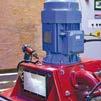








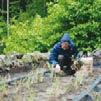


Clean Slate 23 Free, independent and impartial advice on a wide range of topics relating to sustainability. • Energy efficiency • Renewable energy • Retrofit and renovation • Green building • Water and sewage treatment • And more FREE INFORMATION SERVICE cat.org.uk/info info@cat.org.uk +44 (0)1654 705989 Phone line open Monday, Tuesday, Thursday and Friday ✆
Monitoring your heat pump’s performance
As heat pumps edge closer to the mainstream, Joel Rawson looks at the importance of monitoring in making this change successful.
The results of monitoring from wellperforming heat pumps provides examples of good practice that will help more of us to make a successful switch. It also helps other householders or installers improve systems that are not doing as well as expected. This is important because if heat pumps don’t meet expectations, it can damage consumer confidence in one of the best carbon-saving measures available to us. We don’t need full monitoring for all installations, especially once the market is more developed, but it makes sense for systems put in by ‘early adopters’.
Measuring efficiency
The BetaTalk podcast regularly covers heat pumps and how to maximise performance. In an episode last July, CAT graduate Colin Meek, now a partner at energy researchers RB&M, talked about his analysis of monitoring data gathered by Ofgem from hundreds of heat pumps funded through the domestic Renewable Heat Incentive (RHI), a scheme that ran for around eight years until it was replaced with the Boiler Upgrade Scheme in 2022.
Colin’s study found that the average measured efficiency for air source heat pumps in the dataset was 2.71, just under 17% lower than the average predicted efficiency of 3.25 (figures are for the overall ratio of electricity input to heat output across a year). This lower ratio will still give big carbon savings, but householders should be looking for a ratio close to 3 to compete on running costs with the most efficient gas boilers. Although many heat pumps in the studied group were close to that boundary, they should really have been above it. There are examples of heat pumps achieving an electricity-to-heat ratio close to 4, even in old, hard-toinsulate buildings. So, how to address this sub-optimal performance?
Improving performance
Firstly, it's worth bearing in mind that plenty of gas boilers also underperform. Even though condensing boilers have been mandatory for almost two decades, the way many are set up with high flow temperatures means they’re not actually running in condensing mode very often. This means they’re also running about
15% less efficiently than they would with better design.
Just as tweaks to gas boiler settings can help reduce energy use, there are also remedies for a below-par heat pump. This could be as simple as free or cheap changes to control settings, but sometimes it may need more investment, such as upgrading or adding radiators if these were not properly assessed before the heat pump was fitted.

You can also improve the performance of an existing heat pump by gradually increasing insulation levels in your home over time (as savings or grant funding allows). Once you’ve cut down heat loss, the same radiators can be run at a lower flow temperature, keeping your home just as warm but resulting in an improved ratio of electricity to heat.
How monitoring can help
Many heat pumps work well despite the house not meeting modern insulation standards. There could be a few reasons for this, for example getting a better than usual heat loss assessment beforehand to feed into good sizing and design. But a key factor is often that the householder
24 Clean Slate
Shutterstock/Eakrin Rasadonyindee
Heat pumps are one of the best carbon-saving measures available. Monitoring of installations by early adopters can help us make the most of the technology
has good monitoring in place and is using this to fine-tune settings to extract the maximum possible efficiency.
Good monitoring is useful even if you’re not interested in the detail yourself, as it can be fed into a monitoring programme. Gathering data from large numbers of heat pumps in many different house types enables the comparison of factors such as heat loss, emitter sizing, flow rates, buffer tanks, and more. All of this should be fed into improving design standards and giving training and professional development to new and current installers.
For example, the analysis of monitoring data from real-world systems can help with issues like the debate around buffer tanks. Some systems come with them as standard, but several heat pump experts argue against using a buffer tank if possible – saying that if you instead specify enough volume in the heating system (including the radiators) you’ll get a more efficient heat pump.
Building public confidence
Monitoring is one of the recommendations in the report ‘Accelerating the transition to heat pumps’, published last September by the Energy Futures Lab at Imperial College. This also looks at many other important measures – such as better methods for assessing heat loss, to improve the sizing of emitters and heat pumps.
As the study highlights, there is some controversy at the moment in the media about when heat pumps will and won’t work – and this is leading to a lack of confidence in many householders, given the investment and commitment needed to make the switch from a gas boiler.
To address this and other barriers to a rapid decarbonisation of heating, the report recommends improving the
measurement of building performance (rather than using estimations), monitoring the performance of installed heat pumps, and sharing the results of this through a database of case studies.
Metering equipment
The previous RHI grant scheme required heat metering in some cases and offered financial support to people putting in an optional metering monitoring service package (MMSP). As well as giving more information to people about how their heat pump is performing, MMSPs allow for analysis on a much larger scale.
A heat meter needs a few sensors to measure the temperature being delivered, the temperature returning to the heat pump, the flow rate, and the temperature inside and outside the house. The data about heat flows and electricity use can be downloaded, shared online, and used to make graphs and other summaries to help you or others understand and improve how the system is working.
Measuring the (relatively) low temperatures being delivered by a heat pump can be challenging, and the sort of equipment up to the job could well cost several hundred pounds.
Under the new Boiler Upgrade Scheme grant, the monitoring of heat output is optional (not required or supported). Therefore, if you have or are planning to install a heat pump, you could enquire about MMSP or equivalent options if you want to either monitor the system yourself or contribute the data for others to use.
Some heat pump systems come with more detailed monitoring as standard – and one of the useful results of independent monitoring will be to evaluate how effective this built-in monitoring actually is for different

brands. If you’re happy with the technical detail involved, you could set up your own monitoring system. The ‘Heat Pump Monitoring’ section of the Open Energy Monitor website has details of different monitoring setups, what sort of data can be obtained, and lots of links giving more detail – for example, a list of suitable heat meters.
Get in touch
Please contact me if you’d like more information about heat pumps or links to further sources of advice, both online and in your local area. You can email me at info@cat.org.uk or call 01654 705989. CS
About the author
Joel Rawson is CAT's Information Officer, providing free and impartial advice on a wide range of topics related to sustainability. He first came to CAT to volunteer in 2001 and graduated with a CAT Postgraduate Diploma in 2013.
Further information on heat pump monitoring
BetaTalk renewable energy and lowcarbon heating podcast regularly covers heat pump systems and monitoring –betatalk.buzzsprout.com
Heat pump expert and CAT guest lecturer John Cantor has an easily searchable website with a wealth of useful information – heatpumps.co.uk
For those who want to set up their own monitoring, Open Energy Monitor has a section dedicated to heat pumps –openenergymonitor.org
Data from several heat pump systems is available at HeatPumpMonitor.org, which uses Open Energy Monitor equipment. It shows the measured efficiency alongside information about the heat pump being used, the age and type of building, insulation levels, and so on –heatpumpmonitor.org
Trystan Lea of Open Energy Monitor gives a detailed breakdown of his own monitoring setup on his website –https://trystanlea.org.uk/monitoring
If you’d like to see a heat pump in action and talk to people who have them installed in their homes, you can register for Nesta’s ‘Visit a Heat Pump’ scheme (currently at pilot stage) –visitaheatpump.com
Clean Slate 25
Shutterstock/Gorodenkoff
Good monitoring can help you to fine-tune settings to obtain the maximum possible efficiency.

















Business Cards Wedding Invitations Greeting Cards Flyers, Brochures Go Green with Eco-Friendly Promotional Products, Clothing & Workwear ISO 9001 & 14001 ACCREDITED E D E N Grass Paper The New Generation Environmental Paper NEW NEW NEW PERFECT FOR plus much more CALL US ON 01938 552260 EMAIL US AT sales@wpg-group.com VISIT OUR WEBSITE the journal of sustainable living alison@emsm.org.uk Advertise here Reach over 40,000 environmentallyconscious readers and support CAT. Contact Alison:
Short course spotlight Renewables for Households: Heat Pumps
Explore the science, weigh up the costs and benefits, and calculate the emissions reductions of heat pumps, to decide if this technology is right for you.
During this course, we will examine the operating principles of heat pumps, how they work and what conditions they perform best in. We’ll explore the differences between air, ground and water source heat pumps and weigh up the energy efficiency of each.
Through a mix of lectures and hands-on sessions, you’ll learn about the need for detailed design, both of the system and the recipient building. The course will also cover developing a costbenefit analysis and quantifying emissions reductions, enabling you to decide whether heat pumps are suitable for your home, community space or business.
Key information

• Duration: one day
• Upcoming date: Saturday 13th May 2023
• Start and finish times: starts at 10am and ends at 4.30pm
• Fee: £80
• Includes: tuition, all materials
• What to bring: waterproof clothing is recommended
Installing a heat pump requires an understanding of how they work and how to choose the right system for a space.
Your tutor, Dr Alan Owen, will give you all the information you need to get to grips with heat pumps. Alan is a Chartered Energy Engineer and lecturer on our postgraduate courses. His research ranges from numerical modelling of sustainable energy systems and resources in Europe, to developing international sustainable energy policy and strategy in post-conflict/post-disaster areas of Southeast Asia.
A basic knowledge of MS Excel (or equivalent) is desirable for this course.
For more information on this and other CAT courses, please visit www.cat.org.uk/ short-courses or contact us at courses@cat.org.uk
Our thanks to Oceanair for installing the air source heat pump used in our renewable energy training courses CS
What are heat pumps?

Heat pumps extract energy from the outside air or from under the ground and use this to heat buildings. You’ll almost certainly have a heat pump in your home already, because small heat pumps power fridges and freezers. The process is complex, but basically the heat pump is absorbing heat from one place and moving it to another place. Most air conditioning units are heat pumps, as are efficient types of tumble-dryer.
Heat pumps are often advertised as ‘free heat’, as for a small amount of energy in (electricity) they can emit more energy out (as heat). A small amount of electricity is needed to run a compressor and harness the energy available, and this can be from renewable sources.
Renewables for Households courses

This course is part of a series exploring renewable energy technologies for households. Each course can be taken as a standalone or as a series where they will equip you with the skills and knowledge to implement different renewable technologies in your home.
• Renewables for Households: Wind Turbines –Saturday 22nd April 2023
• Renewables for Households: Heat Pumps –Saturday 13th May 2023
Clean Slate 27
If you’d like to explore renewable energy in more depth, take a look at our MSc Sustainability in Energy Provision and Demand Management course, which explores this on a local, national and international scale: cat.org.uk/gse
Shutterstock/Jevanto Productions
Course tutor Dr Alan Owen with our air source heat pump.
Why do we teach… futures literacy for sustainability transformation?
Next in our new series looking at themes and topics explored by students on CAT Masters degrees, Dr Ruth Stevenson looks at how we can plan for an uncertain future – what it means, why it matters and some of the main teaching methods used on our courses.
The climate and biodiversity crisis cannot be tackled with the same practices and mindsets that created it. The need to transform our current systems has long been recognised, with the Intergovernmental Panel On Climate Change (IPCC) as long ago as 2012 calling for a “fundamental qualitative change … that … involves a change in paradigm and may include shifts in perception and meaning, changes in underlying norms and values, reconfiguration of social networks and patterns of interaction, changes in power structures, and the introduction of new institutional arrangements and regulatory frameworks.”
However, each year national decision makers at the UNFCCC Conference of the Parties (COP) struggle to develop a clear and coordinated vision of the future and understand the depth of change needed, let alone establish the ethics
involved in that transformation. The aim of the ‘Introduction to Sustainability and Adaptation Concepts in Practice’ module run by the Graduate School at CAT is to get to grips with these difficult issues.
Why is futures literacy for sustainability transformation important?
To successfully achieve a more sustainable future we need to:
• take a systemic approach to generating knowledge and designing interventions;
• understand that our efforts to intervene can have unintended consequences;
• move beyond ‘predictions’ and encourage people to imagine possible futures;
• acknowledge the uncertainty the future holds.
Changemakers need to be skilled facilitators and contributors in this space.
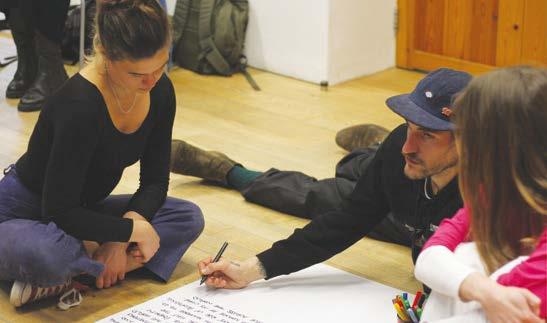
This module therefore forefronts ‘futures literacy’ – the ability to deal with uncertainty and complexity and acknowledge that our actions will have consequences, partly by understanding the past and how it has shaped the present, and also by ‘testing’ a variety of possible futures.
Futures literacy is a key skill for transformational change. Most people struggle to think of a future that is not just an extension of the current state. However, the COVID-19 pandemic has taught us that transformational change can take place, whether we plan for it or let it happen to us. While we will need to adapt to the ‘new’ potential futures being shaped by climate change, we must also transform our practices as we do this.
28 Clean Slate
Students collaborating in person at CAT.
What are the key aspects to consider?
The module is embedded in systems thinking, from its delivery to its learning outcomes. Students are brought together across the MSc courses at CAT to engage in cross-disciplinary working, vital to generate transformational ideas for a sustainable future. This also supports students’ understanding of complex and dynamic social, ecological and technological systems. It enables them to see how ‘seeds’ of ideas that we have now can potentially have long-term positive influences across many disciplines, but also unintended consequences if not considered systemically.
What are the main teaching methods?


The students work in facilitated small groups to carry out three days of future visioning and scenario planning. Participating in person and online, they practise co-creating knowledge and ideas. They engage with the different experiences and world views of others,
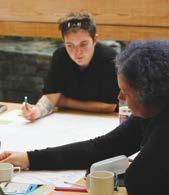
while considering their own power and privilege.
Students are supported in their learning by lectures from contributors from across the globe. Importantly, the module makes space for indigenous knowledges and voices that are less prevalent in academia, acknowledging that we need to be open to different ways of thinking about sustainability.
Acknowledging that the future is uncertain, the students consider a variety of potential futures. After structured discussion, they describe and critique these different scenarios or ‘worlds’:
• What does the landscape look like?
• How do people work and travel?
• What are the energy structures?
• Who makes decisions?
• What values underpin the systems?
• Whose voices are represented and unrepresented?
This story-based approach allows the students to go beyond predictions, targets and roadmaps to understand what transformational change ‘feels’ like. It allows them to engage safely with some of the more difficult emotions and beliefs around the climate and biodiversity crisis.
“The process is really empowering and inspiring. It reminds us that the future doesn’t just happen, it’s created, and can be changed. And it helps us explore ways in which we might most effectively create the changes we want to see in the world.” Student, November 2022.
The final stage of the module is spent developing transformational ideas that would support change towards the better worlds depicted during the group work, or at least avoid the worst. Students start to understand that transformational change needs to be systemic and structural, and developed through co-creative inclusive practices. Each student then develops their own ideas for transformational interventions in an assignment.
How do students use this learning?
The students’ futures literacy supports better decision-making practices and outcomes in the various disciplines they are studying and, ultimately, in their work as changemakers outside CAT. It supports the systemic thinking needed to deal with the complex issues in our socio-ecological-technical world. The development of the transformational adaptation concept for the assignment can be one of the most challenging but also most rewarding parts of the learning from this module. And the experience of listening respectfully to others’ points of view supports students in developing and engaging in ethical and creative processes of change in the real world.
“This latest module has honestly been life changing for me. …I feel like a different person. …through this piece of coursework I am finding inspirational examples of hope and imagining new possibilities.” Student, November 2022. CS
About the author
Ruth is an environmental social scientist, lecturing across the range of taught and research postgraduate courses at CAT. Drawing on experience in renewable energy consultancy, policy making and academic research on policy and discourse she focuses on the nature of socio-technical transformations and working towards social and behavioural transformation. She works closely with CAT’s Zero Carbon Britain Hub to implement systemic change at grassroots and institutional levels.
Study with us
Find out more about CAT Masters degrees, join an on-site or virtual open day, and explore what funding might be available to you – visit cat.org.uk/gse or contact Alis at study@cat.org.uk or on +44 (0)1654 705953.
Clean Slate 29
Lyla June’s contributing lecture from America, interacting with students onsite and online.
Systems thinking requires social, technological, economic, environmental and political issues to be considered.
Dr Leon Sealey-Huggins’ contributing lecture exploring issues around climate justice.

Clean Slate (CS): How did you get involved with CAT?

John: It was the summer of 1982, and I came to CAT to complete my MSc by doing a survey on visitor flows. My MSc was in systems analysis, a far cry from graphic design, but I had in my knapsack a cartoon series I was working on, with a view to getting it published. At the time, there was a plan to re-interpret the site’s signs with cartoon characters, and my drawings caught everyone’s eye. I wholly fell in love with working and living at CAT. I was in the right place at the right time. Working with Graham Preston, who now designs the very magazine you are holding, I spent the next few years working on the site displays and then leaflets, posters, information sheets, and more. I never did complete the MSc.
CS: What does the role of Graphic Designer involve?
John: My design work now spans a wide range of printed and online communications. On a given day, I might be working on visitor centre display signs that help people get to grips with technologies, guidebooks that give people a deeper understanding of what we do, infographics for reports that get across how we could reduce greenhouse gas emissions, or web adverts that bring in vital revenue.
Having been here for so many years, I’ve also acquired an unofficial role as CAT historian, giving guided tours and talks to help tell our 50-year story.
John Urry has been bringing CAT’s communications to life with his creative design skills for more than 40 years. If you’ve navigated your way around our site, been inspired by one of our infographics, or had a complex technology explained through an illustration, there’s a good chance that he had a hand in it.
CS: What’s your fondest memory of your time working and volunteering at CAT, or your proudest moment?

John: The opportunity to work with so many talented people has left me with many fond memories. I need to remind myself that working in an environment where your teammates are also your friends is not a universal experience.
When I started at CAT, I was 23, and I think at that age experiences are more vivid. For example, I have a memory of one stormy night when I helped our site engineer prevent the Cretan windmill from tearing itself apart in the high winds. We had to climb up the slate waste, in the pitch dark and driving rain, furling its sails by hand.

I’m very lucky that I have a job that I find constantly rewarding. I’m proud to help communicate climate solutions and share CAT’s message of hope in this time of crisis.
CS: What do you hope to see CAT achieve in the next five to 10 years?
John: CAT has achieved a reputation as an institution for training and education, and I think that is something to build on in the next five to 10 years. We have reached the critical point where the technology is ready, but we need people with the skills to implement it. CAT has a vital role to play in making that happen.
I’m looking forward to seeing the site itself re-invigorated, with a visitor centre fit for the twenty-first century. We must meet the needs and expectations of people today to stay relevant and deliver the most value. I also hope to see CAT continue to influence and inspire all sorts of people beyond the visitor centre, through online workshops and initiatives like the Zero Carbon Britain innovation labs. All with beautifully designed communications of course! CS

Clean Slate 31 Meet CAT’s Graphic Designer
John is also CAT's unofficial historian, giving tours and talks to help tell our 50-year story.

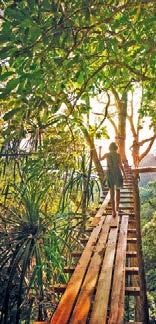

Permaculture offers money-saving ideas in harmony with Nature https://shop.permaculture.co.uk/ permaculture-magazine.html or call 01730 776 582
Crisis ESCAPING THE RAT RACE WITH LIZ ZORAB IN PM104 DARE TO IMAGINE A BETTER FUTURE IN PM105 Subscribe to print or digital and get FREE access on your tablet, mobile and desktop to over 30 years/115 back issues. Search for the subjects YOU are passionate about!
Solutions for the Cost of Living
CAT STORIES
For five decades, CAT has been equipping a diverse community of changemakers with the skills and knowledge to take action in the climate and biodiversity crisis. Here, two people we’ve supported share their inspiring stories with us.
Sarah Marshall Julian Mills
Sarah, a retired senior public health commissioner for a local authority, completed her MSc in Sustainability and Behaviour Change at CAT in 2021.

After completing her dissertation, ‘The nature of work, exploring what factors encourage or discourage public sector commissioning staff to consider environmental impact in the work they deliver’, Sarah volunteered to share her findings with the Office for Health Improvement and Disparities (North West England). This stimulated a conversation with Health Education England (NW) to provide training for NHS staff and local government officers on sustainability and climate awareness, in which Sarah has been involved.
Alongside making an impact on local government and public services, Sarah has also stood in county council elections in Llangollen, translating her knowledge gained at CAT into action to make a tangible difference to her community.
Sarah says: “I chose to study at CAT because of the course and location, and the flexibility to combine elements of sustainability and behaviour change. I was diagnosed with stage 4 cancer just before starting my studies, and I found the course gave me something meaningful to focus on away from my health experiences. I felt a real sense of achievement as I had not studied formally since my degree 30 years ago! I loved the peer engagement on the course, the immersion of onsite weeks, and the variety of input from experts, lecturers and speakers.
“Studying at CAT has enabled me to give back to my community, society and planet earth, from a position of understanding, empathy and knowledge.”
Julian graduated from CAT in 2013 with a Professional Diploma in Sustainable Architecture. After working for larger sustainable architectural practices, he felt there was something missing from the way he was creating and delivering design work. This led him to set up his own architecture practice on the Cornish coast.

Julian is now the founding director of STUDIO/gather, a small architectural studio in Cornwall specialising in sustainable architecture. The team at STUDIO/gather are all CAT graduates who have gravitated to the practice because of its ethos of touching the earth lightly. The business is now recruiting more designers and technicians to focus on sustainable architecture principles and design with purpose.
STUDIO/gather is currently making waves in the architectural community, both locally and further afield, becoming renowned for what they do. Working both on projects that satisfy the architectural itch to create something new and in the retrofit sector, the practice has an impact across a broad cross section of projects and clients.
Julian says: “CAT and the sustainable architecture course have been the foundation for who I have become as an architect, a designer, and likely a person. CAT is not just a course, it is a community, and over the past 10 years is still a daily point of contact for me.”
In CAT’s 50th year, we’ll be collecting and sharing even more of your stories. Please email us at members@cat.org.uk to tell us how CAT has influenced your work, volunteering or daily life, and what the community means to you.
Clean Slate 33











if icon is smaller than 15mm wide use 2nd version Oliver
Bush
Airseal
Meg
Airseal Chelsea
all available at www.vegshoes.com Gorgeous new Vegan Styles... ICE PATROL (BROWN) OFFICE 22 SHOE (BLACK) Airseal 3 Eye
Airseal 10 Eye Boot (White) clean slate 1/2 page ad 0223.indd 1 07/02/2023 11:50 organic bedding, textiles & homewares since 1996
Shoe (Tan)
Boot (Sand)
Chelsea Boot (White)
Boot (Black)
Boot (Purple)
Shoe (White)
Cryptic crossword by Brominicks

http://www.brominicks.wordpress.com
Across
2 All but half of Garfield is blubber (3)
6 CAT crowd behind green revolution (6)
8 Answering clue, rely on selecting the initial characters! (8)
10 CAT lover reflects with English football legend and top Spanish manager (4,2,3)
11 CAT staff, ahead of the times (4)
12 Murder mystery could lead to establishing criminal (6)
13 People likely to steal footwear (8)
15 CAT food with a bit of soya in – a dessert (6)
17 Discover 25 hugging nurse (6)
20 Fuel made from rubbish prolonging endless traffic (8)
23 Content to dribble around number four, Mo ultimately missed (6)
To enter:
Name:
Address:
Email:
Phone:
The first correct entry pulled from a hat wins a £20 voucher for the CAT EcoStore – store.cat.org.uk.
Please send your completed crossword entry by 30 April 2023 to Clean Slate Crossword, Centre for Alternative Technology, Machynlleth, Powys, SY20 9AZ.

Solution will be published in the next issue of Clean Slate
hetreed ross architects



25 CAT expected to take on head of development (4)
26 CAT making alternative to milk, with grain (9)
27 Component that's triangleshaped (8)
28 CAT woman split stake with a stone (6)
29 25% off top – man, that's great! (3)
Down
1 Zero Carbon Paul excited about returning to North American resort (8)
2 Sylvester back on CBeebies – an unlikely story? (8)
3 CAT vehicle carries a doctor, south (7)
4 Scan hilltops using audio equipment (6)
5 Notice gold arriving at address in Italy (6)
7 Part of church left, at first, to go to the dogs (5)
9 CAT has Mike bunging rubbish in skip (7)
14 Take legal action against loud-mouthed American? (3)
15 Steam open envelopes on the way to Barnet (3)
16 Cat breed essentially Asian, south-eastern admits setter (7)
17 Arrange bus north and head for Asian capital (8)
18 Previous partner from the West country, about right for CAT (5,3)
19 Black-tailed working cat (7)
21 Manul, when upset, one goes for the pupils (6)
22 CAT obscured by variable fog and rain, mostly (6)
24 Water leaks after temperature finally drops (5)
Clean Slate 126 Solution
Advertise here
Reach
alison@emsm.org.uk
contemporary • sustainable • passivhaus t: 01225 851860 www.hetreedross.com the journal of sustainable living
over 40,000 environmentally-conscious readers and support CAT.
Contact Alison:
Keeping CAT’s pioneering spirit alive
Freya Randall, Fundraising Manager

Our visitors, members and supporters have been at the heart of CAT for 50 years and continue to make everything we do possible. As we look to the future, and where our ambitious strategy will take us next, we look back with gratitude at the generous support of the CAT community.
We feel especially grateful to those who have decided to leave a gift to CAT in their will, to secure our ongoing work to provide people with the skills, knowledge and understanding to make change happen.

We will be sharing more stories from our supporters and legacy pledgers throughout the rest of our 50th year. We hope you’ll continue to join us in celebration of everything we’ve achieved together, only possible with the support of people like you.
To learn more about leaving a gift to CAT in your will, please get in touch with me at freya.randall@cat.org.uk or on 01654 523015. Thank you for being such an important part of our story. CS
First visits
“I visited CAT for the first time in 1977, when it was in its infancy. I was accompanied by my husband and parents-in-law. We were very impressed with the whole ethos of the project and, although I didn’t visit again for many years, I never forgot the pioneering spirit of CAT.”
Protecting the future
“I have visited three times in the last 10 years and regularly receive ‘ Clean Slate’. An article in this magazine prompted me to make the decision to leave a gift to CAT in my will. I wanted to protect the future of the charity, as a symbol of my belief in CAT’s work and for the benefit of future generations. I have four grandsons and am very concerned about the future of our planet for them. They have been brought up to respect their environment and my hope is that they will visit CAT when they are a little older, and perhaps become volunteers or do a course there.
“CAT is doing a fantastic job. I really admire the progress made in the education department, with so many courses now running.”
Leaving a gift
“I will be leaving CAT a painting. It was given to me by my late mother-in-law (who visited CAT with me in 1977). So, the painting is a gift from us both.
“I think that many people shy away from making a will. However, leaving a donation or a gift is a way of thanking a charity for their current work and, hopefully, for their future work. I feel proud to be leaving CAT a gift!
“To someone who is undecided about leaving a gift in their will, I would talk about the wonderful work CAT do and the example they set for us all. I would encourage them to think of the generations to come, and how their gift could be vital to our planet.”
Elizabeth How, CAT supporter
36 Clean Slate
Elizabeth’s story
ECOSTORE
01654 705959
mail.order@cat.org.uk
https://store.cat.org.uk
UK guides for bees, birds and butterflies. Each chart is clear, colourful and compact – a handy tool for identification in the field
A Year in British Wildlife: A Detailed Account Of The Changing Seasons
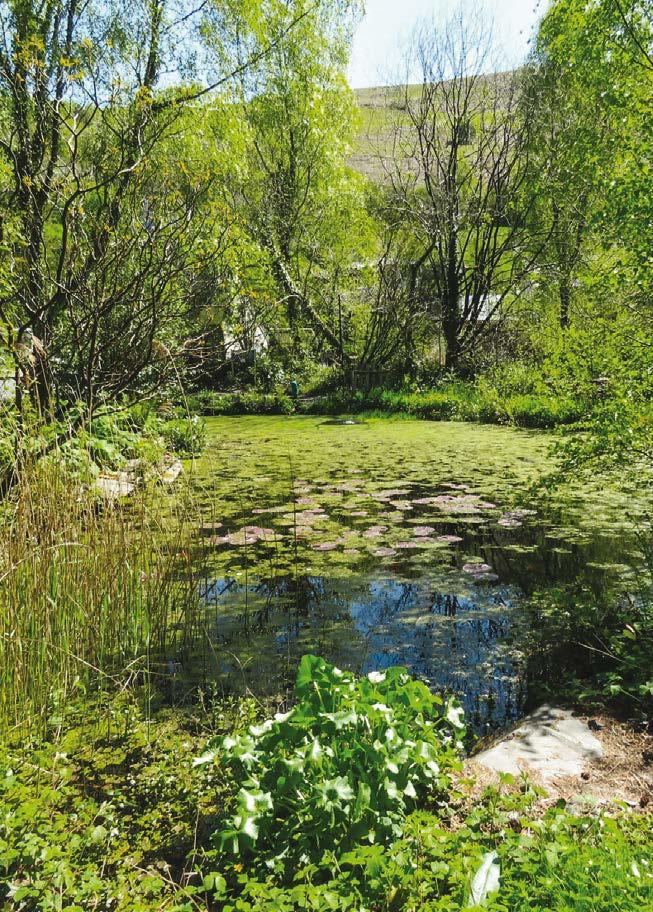
And Its Effects On British Wildlife: was £14.99 now £9.99.

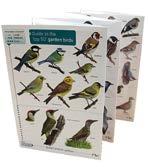

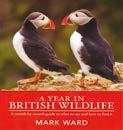
This month-by-month guide outlines the best wildlife spectacles throughout the year and offers advice on where best to spot different species.
The Jungle Garden: £9.99


A wonderful introduction to the hundreds of small creatures living in our gardens and the myriad ways that we can encourage them to thrive.
Friendly Bug Barn: was £28 now £18 With multiple different textures, crevices and hollows, this barn can be a great home for a wide range of insects, including ladybirds, lacewings, solitary bees and over-wintering butterflies.
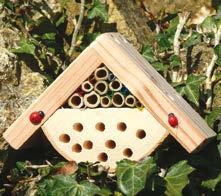

Nature Trail Insect Viewer: £5

Study insects at 2x magnification and explore the natural world. Great for kids, though small parts make it unsuitable for children under 3 years.
Minibugs – Bobby’s Bug Box: £10
A great way for children to learn about bugs and help provide them with a safe habitat. Comes with a magnifying glass and activity book. Ideal for budding conservationists.
The Foragers Garden: Grow an Edible


High performance & environmentally friendly building products from renewable sources ECOLOGICAL ♦ SUSTAINABLE ♦ NATURAL ♦ LOW CARBON MIKE WYE Available from Tel: 01409 281644 | www.mikewye.co.uk | sales@mikewye.co.uk Insulate properly for a healthy home
fibre insulation
wood










































 Shutterstock/BMJ
Shutterstock/BMJ





























































































